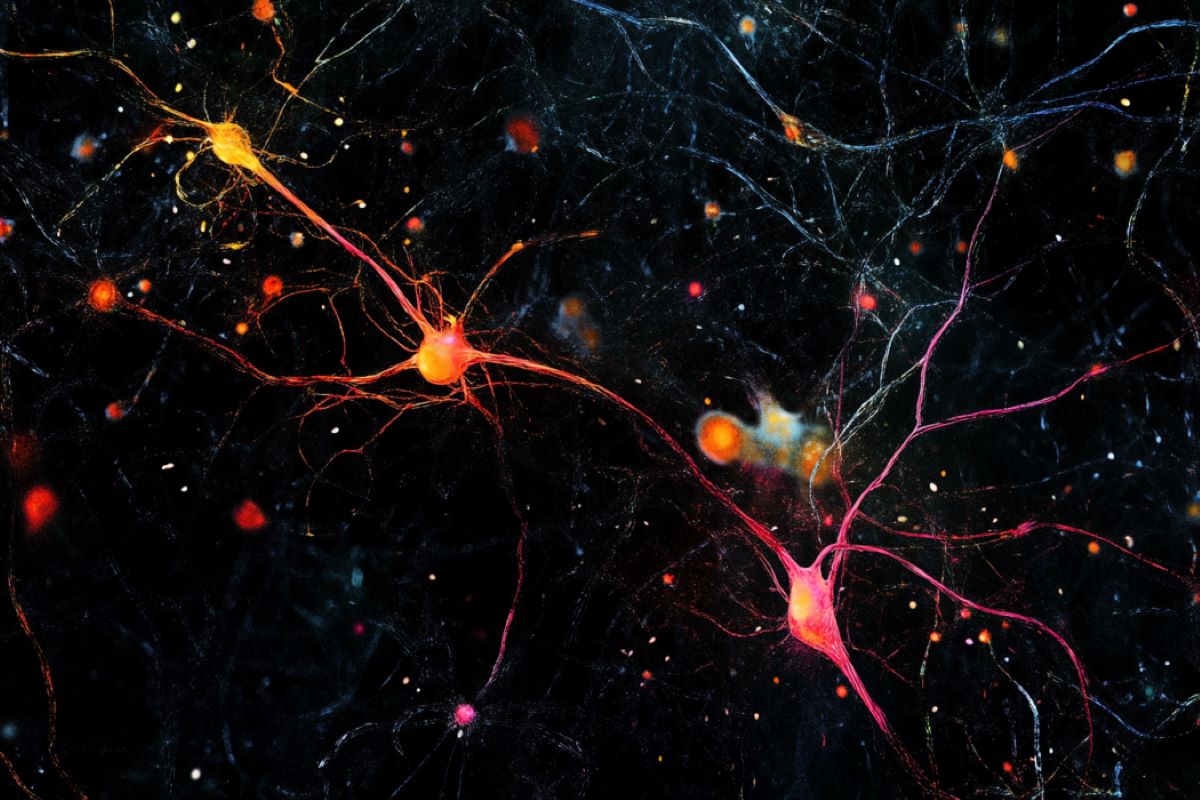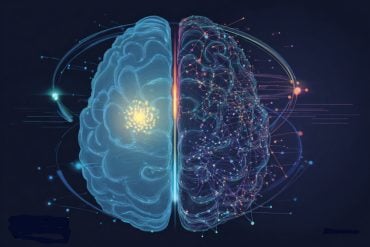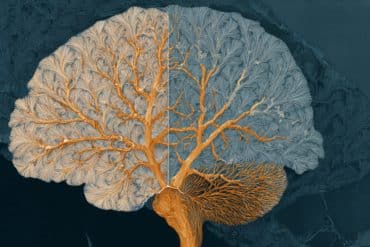Summary: New research has revealed the diverse assembly and regulation of Type-A GABA receptors (GABAARs), which are crucial for balancing brain activity. Using cryogenic electron microscopy, researchers identified over 324,000 potential receptor structures, shaped by subunit combinations and their relative arrangement.
These variations influence receptor function, drug binding, and the brain’s response to stressors like pregnancy or chronic drug use. The findings pave the way for targeted therapies that enhance receptor-specific functions without inducing tolerance or dependence.
Key Facts:
- GABAARs can form over 324,000 structures, varying by subunit composition.
- Receptor adaptations impact brain balance in conditions like postpartum depression.
- Insights could lead to precise drugs targeting receptor-associated proteins.
Source: AAAS
A healthy brain balances “activate” and “inhibit” signaling in its neural microcircuitry, with the inhibitory signaling often provided by cell receptors for the neurotransmitter GABA.
Unexpected variations in composition or relative arrangement of the subunits that make up these receptors, called Type-A GABA receptors (GABAARs), may provide new layers of regulation to fine-tune the inhibitory tone, according to research led by Andrija Sente of the Medical Research Council Laboratory of Molecular Biology in Cambridge, who now works at InstaDeep.

For this glimpse at the atomic structure of GABAARs, their diversity, and for structural insights into the long-sought mechanism of receptor assembly, Sente is the grand prize winner in cell and molecular biology of the 2024 Science & SciLifeLab Prize for Young Scientists.
Sente’s research used cryogenic electron microscopy to reveal the molecular structure of GABAA receptors formed by various subunit combinations. He and his colleagues found that these subunits can assemble in unique ways, creating or removing sites where natural molecules or drugs can bind.
They also discovered that a single neuron can assemble structurally and functionally distinct receptors to respond to combinations of neurotransmitter signals, Sente writes in his prizewinning essay published Nov. 15 in Science.
GABAARs are already targeted by drugs to treat anxiety, seizures and during general anesthesia. But the new research highlights how specific subunit combinations may create previously unrecognized receptor types, underscoring the need to account for these variations in drug development to avoid unintended binding sites.
“To improve therapies that target GABAA receptors, we really need to understand how these receptors are made in the cell,” Sente said.
When the neurotransmitter GABA binds to a GABAaR on a signal-receiving neuron, the receiving neuron becomes less active or inhibited. GABA is the primary inhibitory neurotransmitter in the brain, said Sente.
“In addition, the roles of GABAaRs are increasingly recognized in peripheral systems, for example in pancreatic and immune signals or in the brain-to-gut communication.”
GABAaRs are made up of 19 molecular subunits, and different structures produced by different combinations of these subunits lead to different functions of the receptor. Researchers previously thought there might be about 800 different receptor types.
With new information gleaned from their research, such as the importance of the relative arrangement of subunits, Sente and colleagues calculated there could be as many as 324, 727 possible receptor structures.
“I think it is important here to distinguish two related but different questions: which receptors can be assembled, and which do get assembled under physiological conditions,” Sente said.
“In neurons and other tissues expressing GABAaRs, assembly is constrained by a number of factors,” he explained.
“For example, subunit expression is developmentally programmed, as well as tissue- and cell-type specific. It is also possible that in some cases certain subunits never ‘meet’ each other as they are translated in different parts of the cell.”
Sente said the assembly of different GABAaRs could be dynamically adjusted, possibly through mechanisms that regulate the production of specific subunits at the neuronal synapse.
There are known cases of longer-term adjustment in GABAaRs signaling, he added. Levels of the hormone progesterone increase during pregnancy and make GABA activate certain GABAaRs more efficiently.
To maintain the balance between activation and inhibition, neurons somehow—Sente said the mechanism is unclear—reduce the number of GABAaRs containing a subunit that is sensitive to progesterone.
These receptor numbers usually rebound after pregnancy, but if they are slow to recover, they can cause an activation-inhibition imbalance that is thought be connected to postpartum depression.
“These insights have inspired one of the better examples of rational drug design in psychiatry: the development of brexanolone, a progesterone analog, which shows remarkable efficacy in treating postpartum depression,” Sente said.
Similar adaptations also result from chronic drug use. A deeper understanding of these adaptation pathways may allow the design therapeutics that do not induce tolerance or dependence.
As a first step toward this goal, Sente and his colleagues determined the structure of a partially assembled GABAAR bound to the assembly factor NACHO, offering the first glimpse into the mysterious process of GABAAR assembly.
These findings are timely, given the growing interest in targeting receptor-associated proteins therapeutically rather than the receptors themselves. For instance, this research could help selectively enhance the neuronal expression of nicotinic acetylcholine receptors (whose assembly is also mediated via NACHO).
Such an approach may offer new therapeutic avenues for Parkinson’s and Alzheimer’s diseases, where the loss of these receptors has been documented.
The Science & SciLifeLab Prize for Young Scientists acknowledges that global economic health is dependent upon a vibrant research community that needs to incentivize the best and brightest to continue in their chosen fields of research, as they begin their scientific careers.
2024 FINALISTS:
Gabriele Casirati is a molecular medicine finalist for his essay, “To target, to escape, perchance to cure.” Casirati received his medicine degree from Università degli Studi di Milano and completed his hematology residency at Università Vita-Salute San Raffaele. In 2020 he joined Dana-Farber Cancer Institute as a research fellow and, in 2023, he received a Ph.D. in molecular and translational medicine from Università Milano-Bicocca.
He is a senior postdoctoral fellow at Boston Children’s Hospital. His research focuses on immune engineering strategies to enhance targeted immunotherapies for hematological malignancies and hematopoietic stem cell transplantation.
Sabrina Rondeau is an ecology and environment finalist for her essay, “Digging below the surface.” Rondeau received an undergraduate degree from the Université du Québec à Trois-Rivières, an M.Sc. from the Université Laval, and a Ph.D. from the University of Guelph. She is a postdoctoral fellow at the University of Ottawa.
Her research explores the far-reaching consequences of human activities on wild pollinators, including agricultural intensification, pesticide use and climate change.
Jarrod Shilts is a genomics, proteomics and systems biology finalist for his essay, “How to build a human.” Shilts received an undergraduate degree from Vanderbilt University and a Ph.D. from the University of Cambridge.
He then transitioned to a spin-out biotechnology company specializing in the kinds of difficult-to-express proteins he worked with during his doctoral degree. The research group he leads develops technologies to advance the production of new therapeutic proteins.
About this neuroscience research news
Author: Meagan Phelan
Source: AAAS
Contact: Meagan Phelan – AAAS
Image: The image is credited to Neuroscience News
Original Research: Open access.
“Gatekeepers of the brain: Identifying hidden mechanisms of type A GABA receptor signaling and assembly” by Andrija Sente et al. Science
Abstract
Gatekeepers of the brain: Identifying hidden mechanisms of type A GABA receptor signaling and assembly
nformation processing in the brain requires a precise balance between excitation and inhibition in the neuronal microcircuitry, and targeted alteration of this balance is used in the treatment of numerous psychiatric disorders.
A mild shift toward inhibition alleviates anxiety and its associated symptoms or controls seizures, and enhancing inhibition even further induces unconsciousness in general anesthesia.
A common denominator in these examples is that control over the inhibitory tone is achieved by modulating the same protein target: type A γ-aminobutyric acid receptors (GABAARs).
One might be inclined to think that a deep mechanistic understanding laid the foundation for these therapeutic success stories, but nothing could be further from the truth.
The first generations of anxiolytics, anticonvulsants, and general anesthetics were all synthesized before the identification of their protein target.
Unfortunately, few therapies come without side effects, and the ones listed above are no exception.






